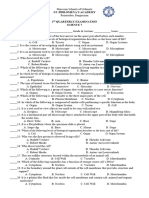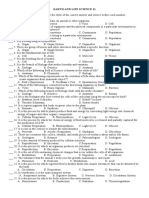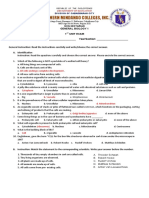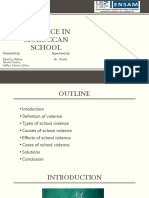0 ratings0% found this document useful (0 votes)
86 viewsFinal Exam G10
Final Exam G10
Uploaded by
Cza VerwinThis document appears to be a science exam for 10th grade students covering topics related to biology, genetics, and the nervous system. It consists of multiple choice and identification questions that assess students' understanding of key concepts. Some of the main ideas addressed include plant tropisms, components and functions of the nervous system, DNA structure and heredity, infectious diseases, and scientists who made important discoveries in genetics. The exam is designed to evaluate students' mastery of 10th grade level science concepts taught in the class.
Copyright:
© All Rights Reserved
Available Formats
Download as DOCX, PDF, TXT or read online from Scribd
Final Exam G10
Final Exam G10
Uploaded by
Cza Verwin0 ratings0% found this document useful (0 votes)
86 views3 pagesThis document appears to be a science exam for 10th grade students covering topics related to biology, genetics, and the nervous system. It consists of multiple choice and identification questions that assess students' understanding of key concepts. Some of the main ideas addressed include plant tropisms, components and functions of the nervous system, DNA structure and heredity, infectious diseases, and scientists who made important discoveries in genetics. The exam is designed to evaluate students' mastery of 10th grade level science concepts taught in the class.
Original Description:
final examination in science 10
Copyright
© © All Rights Reserved
Available Formats
DOCX, PDF, TXT or read online from Scribd
Share this document
Did you find this document useful?
Is this content inappropriate?
This document appears to be a science exam for 10th grade students covering topics related to biology, genetics, and the nervous system. It consists of multiple choice and identification questions that assess students' understanding of key concepts. Some of the main ideas addressed include plant tropisms, components and functions of the nervous system, DNA structure and heredity, infectious diseases, and scientists who made important discoveries in genetics. The exam is designed to evaluate students' mastery of 10th grade level science concepts taught in the class.
Copyright:
© All Rights Reserved
Available Formats
Download as DOCX, PDF, TXT or read online from Scribd
Download as docx, pdf, or txt
0 ratings0% found this document useful (0 votes)
86 views3 pagesFinal Exam G10
Final Exam G10
Uploaded by
Cza VerwinThis document appears to be a science exam for 10th grade students covering topics related to biology, genetics, and the nervous system. It consists of multiple choice and identification questions that assess students' understanding of key concepts. Some of the main ideas addressed include plant tropisms, components and functions of the nervous system, DNA structure and heredity, infectious diseases, and scientists who made important discoveries in genetics. The exam is designed to evaluate students' mastery of 10th grade level science concepts taught in the class.
Copyright:
© All Rights Reserved
Available Formats
Download as DOCX, PDF, TXT or read online from Scribd
Download as docx, pdf, or txt
You are on page 1of 3
UNIVERSAL EVANGELICAL CHRISTIAN SCHOOL (UECS), INC.
SY: 2019-2020
FINAL EXAMINATION
SCIENCE 10
_________
_________
Name: _________________________ Date: _______________
30
Grade & Section: Grade 10 Parent’s Signature: _________
Teacher: Ms. Czarina D. Verwin
I. Multiple Choices. Directions: Read and understand each statement carefully.
Write the letter of the correct answer before the number.
1. The process by which plants grow in a certain direction in response to a
stimulus is called _______
A. tropism C. plant feedback
B. reflex D. feedback mechanism
2. The cerebellum is the cite for managing __________
A. behavior C. motor activity
B. memory D. respiration
3. Aside from hearing, the ears help in maintaining _______
A. balance C. hormone secretion
B. brain function D. nerve pressure
4. The Hershey-Chase experiment concluded that _________
A. DNA has four nucleotide bases
B. DNA is the hereditary material
C. protein is the hereditary material
D. DNA base concentrations are the same for all organisms
5. A base sequence of one strand AATTCG has the complementary strand of __
A. AATTCG C. TTAAGC
B. TTAACG D. TTGGAC
6. They read the impulses sent by sensory neurons.
A. Sensory neurons C. efferent neurons
B. Interneurons D. Motor Neurons
7. Caused by certain bacteria found in soil contaminated with
animal waste.
A. Encephalitis C. Rabies
B. Meningitis D. Tetanus
8. The peripheral nervous system includes the ______
A. brain C. spinal cord
B. nerves D. synapse
9. It is the response of plants to changes in temperature or heat.
A. Heliotropism C. thigmotropism
B. thermotropism D. chemotropism
10. The surface of the cerebrum is called __________
A. cerebellum C. cerebral cortex
C. cerebral wrinkle D. cerebral complex
11. A bacterium that releases neurotoxin that affects the muscles and nerves.
A. Clostidium tetani C. Clostridium Tetani
B. tetanus D. HSV
12. He established the basic principles of heredity.
A. Frederick Griffith C. Oswald Avery
B. Gregor Mendel D. Phoebus Levene
13. ____ are known to be “the windows of the world”
A. eyes C. ears
B. nostrils D. mouth
14. Movement, pressure, and tension are received by the ___________
A. chemoreceptors C. photoreceptors
B. mechanoreceptors D. thermoreceptors
15. These are senses that provide information about internal organs.
A. general senses C. special senses
B. somatic senses D. visceral senses
II. Identification. Directions: Identify what is being described or exemplified in
each statement below. Write you answer on the space provided before the
number.
___________ 16. Viral infection transmitted through bites by infected animals.
___________ 17. Basic functional units of structure and function of nervous
system.
___________ 18. The brain disorder associated with muscular rigidity and resting
tremor.
___________ 19. Responsible for making the plants’ roots grow deeper into the
soil.
___________ 20. _________ tropism is the growth toward the stimulus.
____________ 21. A reflex that does not involve the brain.
____________ 22. He established the fact that DNA is composed of four nucleotide
bases.
____________ 23. He found that each species has a unique percentage of each
type of nucleotide.
____________ 24. He first conducted the transformation experiment.
____________ 25. Part of peripheral nervous system that is under the direct
control of the conscious mind.
____________ 26. Number of bases in every 360° turn.
For numbers 27-30
What are the four nucleotide bases consisting DNA?
You might also like
- Folk Magic and Protestant Christianity in AppalachiaDocument35 pagesFolk Magic and Protestant Christianity in AppalachiaViktorija Briggs100% (6)
- Marketing Budget 2022 (KMED)Document8 pagesMarketing Budget 2022 (KMED)AJ SinambanNo ratings yet
- Quiz No. 1 Science 6 Second Quarter Name: - Grade: - I. Choose The Letter of The Correct Answer. Write Your Answer On The BlankDocument2 pagesQuiz No. 1 Science 6 Second Quarter Name: - Grade: - I. Choose The Letter of The Correct Answer. Write Your Answer On The BlankCecilia Guevarra Dumlao90% (10)
- Summative-Test in Science 10Document8 pagesSummative-Test in Science 10trexia autida0% (1)
- Practice 3-M12Document7 pagesPractice 3-M12Châu Nguyễn NgọcNo ratings yet
- First Quarterly Test: General Biology 2Document10 pagesFirst Quarterly Test: General Biology 2glaiza abucayNo ratings yet
- Eart and Life TQ FinalDocument3 pagesEart and Life TQ FinalNel PasaizNo ratings yet
- Ôn CNDocument4 pagesÔn CNNevermore 12154No ratings yet
- St1-Science-Grade 6-Q2Document1 pageSt1-Science-Grade 6-Q2MilainNo ratings yet
- SCIENCE 7 2ND QuarterDocument3 pagesSCIENCE 7 2ND Quarterjuliusvaldez07201996No ratings yet
- Wk5-Sc-G8-Mid Semester RevisionDocument6 pagesWk5-Sc-G8-Mid Semester Revisionfareedegypt007No ratings yet
- Grade 10 - Quiz Review 1Document2 pagesGrade 10 - Quiz Review 1Jazmine ManaloNo ratings yet
- Science 7 DTDocument2 pagesScience 7 DTMary Cris D. LlanoNo ratings yet
- 2ND Pre - Science 6Document3 pages2ND Pre - Science 6Gia Shayne DelicanaNo ratings yet
- I. MULTIPLE CHIOCES: Encircle The Letter of The Correct AnswerDocument2 pagesI. MULTIPLE CHIOCES: Encircle The Letter of The Correct AnswerArniel CatubigNo ratings yet
- Ultiple HoiceDocument4 pagesUltiple HoiceChari MembrillosNo ratings yet
- Wk5-Sc-G8-Ak-Mid Semester RevisionDocument6 pagesWk5-Sc-G8-Ak-Mid Semester Revisionfareedegypt007No ratings yet
- Second PT7 For PrintDocument3 pagesSecond PT7 For PrintMarlene Tubieros - InducilNo ratings yet
- Q3, G10 Scie Summative Test FinalDocument3 pagesQ3, G10 Scie Summative Test Finalangel pranadaNo ratings yet
- The Nervous System Test FinalDocument6 pagesThe Nervous System Test FinalmaeNo ratings yet
- REGULAR SCIENCE 7 QUARTER EXAMINATION 50 ItemsDocument3 pagesREGULAR SCIENCE 7 QUARTER EXAMINATION 50 ItemsGojo KaisenNo ratings yet
- KEY MED 2 Updated 2021 Feb Unit 81Document10 pagesKEY MED 2 Updated 2021 Feb Unit 81huyenhungho5892No ratings yet
- General Biology QuizDocument2 pagesGeneral Biology QuizQueng Eledia100% (2)
- 1st Quarterly Exam in General BioDocument6 pages1st Quarterly Exam in General BioVinlax Arguilles100% (1)
- Quarterly-Test-1st-Quarter Science 9Document3 pagesQuarterly-Test-1st-Quarter Science 9Gavin MalalaNo ratings yet
- Periodical Exam Science 9Document2 pagesPeriodical Exam Science 9Jhey EmNo ratings yet
- General Biology 1 QuizDocument2 pagesGeneral Biology 1 QuizQueng Eledia100% (1)
- G-9 Summative Test 2 (WK 3-4)Document3 pagesG-9 Summative Test 2 (WK 3-4)Colleen RubiaNo ratings yet
- General Biology Midterm Examination: Senior High School Department Academic Year 2021-2022Document3 pagesGeneral Biology Midterm Examination: Senior High School Department Academic Year 2021-2022Ronald ValenzuelaNo ratings yet
- PT g7 ScienceDocument5 pagesPT g7 ScienceHAROLD MORALESNo ratings yet
- SCIENCE 7 2nd MidtermDocument2 pagesSCIENCE 7 2nd Midtermjuliusvaldez07201996No ratings yet
- Grade 11 (Sum Test)Document2 pagesGrade 11 (Sum Test)Yvuj LagnitabNo ratings yet
- KEY ĐỀ ADocument4 pagesKEY ĐỀ AHải BằngNo ratings yet
- Science Quiz 1Document1 pageScience Quiz 1Neptune LopezNo ratings yet
- Năm học ;2019-2020 Môn; tiếng anh - bảng không chuyên Thời gian; 180 phút Ngày thi;19/9/2019Document12 pagesNăm học ;2019-2020 Môn; tiếng anh - bảng không chuyên Thời gian; 180 phút Ngày thi;19/9/2019Văn ThànhNo ratings yet
- Biology Unit Test Practice Answers Dec 2014Document4 pagesBiology Unit Test Practice Answers Dec 2014t4jr7g5mjyNo ratings yet
- Second Quarterly ScienceotasDocument2 pagesSecond Quarterly ScienceotasDiether Mercado PaduaNo ratings yet
- 2ND PTE ReviewerDocument2 pages2ND PTE ReviewerSumire KakeiNo ratings yet
- Review Topic 31 (Bank)Document24 pagesReview Topic 31 (Bank)syam97253No ratings yet
- 2nd Quarter Grade 7Document2 pages2nd Quarter Grade 7Genalyn Cirpo TayoneNo ratings yet
- Q1 Exam Gen Bio TO PRINTDocument7 pagesQ1 Exam Gen Bio TO PRINTrey.quimno002No ratings yet
- Science 4 - 2ND QuarterDocument5 pagesScience 4 - 2ND QuarterRica VillanuevaNo ratings yet
- Review Test With AnswersDocument49 pagesReview Test With AnswersAdam VNo ratings yet
- Your Answers in The Corresponding Numbered Boxes ProvidedDocument8 pagesYour Answers in The Corresponding Numbered Boxes ProvidedHoàng NguyễnNo ratings yet
- Ch. 31 Eoc ReviewDocument11 pagesCh. 31 Eoc ReviewQussayNo ratings yet
- 3rd Summative TestDocument8 pages3rd Summative Testlorna gonzalesNo ratings yet
- Grade 10 - Quiz Review 2Document1 pageGrade 10 - Quiz Review 2Jazmine ManaloNo ratings yet
- Chaptest BDocument4 pagesChaptest BKim KimNo ratings yet
- Third Prelims in Science 10Document3 pagesThird Prelims in Science 10Eunice CorreaNo ratings yet
- 2ndmontly Science7Document3 pages2ndmontly Science7angge21No ratings yet
- M1 Science Test-Cells: Multiple ChoiceDocument5 pagesM1 Science Test-Cells: Multiple ChoiceBillD100% (1)
- Biological Bases of Behavior: Identify The Choice That Best Completes The Statement or Answers The QuestionDocument10 pagesBiological Bases of Behavior: Identify The Choice That Best Completes The Statement or Answers The QuestionVedant Shivaji ShelkeNo ratings yet
- PT - 2ND - S7 (Revised)Document2 pagesPT - 2ND - S7 (Revised)Ica Norada TrinidadNo ratings yet
- I. /58 II. /28 Total: Strictly No Erasures and Alterations Only in Multiple-Choice PartDocument2 pagesI. /58 II. /28 Total: Strictly No Erasures and Alterations Only in Multiple-Choice PartBren DonatosNo ratings yet
- last-quarterly-examination-in-Earth-and-Life-Science 2nd Q.Document6 pageslast-quarterly-examination-in-Earth-and-Life-Science 2nd Q.Marina AbanNo ratings yet
- Đề thi Tiếng Anh học kì 2 Đề 6: Find the word which has a different sound in the part underlinedDocument9 pagesĐề thi Tiếng Anh học kì 2 Đề 6: Find the word which has a different sound in the part underlinedThiện TrầnNo ratings yet
- Science 7-7TH Monthly Test-2024Document2 pagesScience 7-7TH Monthly Test-2024Jam AstreroNo ratings yet
- 1ST UNIT EXAM Gen Bio 1key AnswerDocument4 pages1ST UNIT EXAM Gen Bio 1key AnswerMea-Ann OscianasNo ratings yet
- 2nd Quarter Summative Test No.1 in Science 6Document1 page2nd Quarter Summative Test No.1 in Science 6Marilou Kimayong91% (11)
- 7thFinalExamS2 20172Document7 pages7thFinalExamS2 20172sheu.winnie3981No ratings yet
- FInal Gen Bio 1Document4 pagesFInal Gen Bio 1roselyn acpacNo ratings yet
- The Collapse of Darwinism: How Medical Science Proves Evolution by Natural Selection Is a Failed TheoryFrom EverandThe Collapse of Darwinism: How Medical Science Proves Evolution by Natural Selection Is a Failed TheoryNo ratings yet
- Unit 3 Chapter 4Document59 pagesUnit 3 Chapter 4Cza VerwinNo ratings yet
- Table of Specification: Basic Education DepartmentDocument1 pageTable of Specification: Basic Education DepartmentCza VerwinNo ratings yet
- Memorandum of AgreementDocument23 pagesMemorandum of AgreementCza VerwinNo ratings yet
- Event Costing Estimated Budgetary Requirements Particulars Remarks Total AmountDocument1 pageEvent Costing Estimated Budgetary Requirements Particulars Remarks Total AmountCza VerwinNo ratings yet
- Chapter4 Opt3Document30 pagesChapter4 Opt3Cza VerwinNo ratings yet
- Non-Mendelian Genetics: Inheritance Patterns That Don't Follow The RulesDocument29 pagesNon-Mendelian Genetics: Inheritance Patterns That Don't Follow The RulesCza VerwinNo ratings yet
- Non-Mendelian GeneticsDocument37 pagesNon-Mendelian GeneticsCza VerwinNo ratings yet
- Heredity: Week 4Document29 pagesHeredity: Week 4Cza VerwinNo ratings yet
- Potential and Kinetic EnergyDocument27 pagesPotential and Kinetic EnergyCza VerwinNo ratings yet
- The Origin of The Solar SystemDocument29 pagesThe Origin of The Solar SystemCza VerwinNo ratings yet
- How Does Temperature, Particle Size, and Agitationaffect HowDocument14 pagesHow Does Temperature, Particle Size, and Agitationaffect HowCza VerwinNo ratings yet
- Endocrine DiseasesDocument15 pagesEndocrine DiseasesCza Verwin0% (1)
- Hypothesis, TheoryDocument5 pagesHypothesis, TheoryCza VerwinNo ratings yet
- What Do You Think Will Happen If Hormones Are Not RegulatedDocument15 pagesWhat Do You Think Will Happen If Hormones Are Not RegulatedCza VerwinNo ratings yet
- Physci 12 PrelimDocument2 pagesPhysci 12 PrelimCza VerwinNo ratings yet
- Final Sci5Document2 pagesFinal Sci5Cza VerwinNo ratings yet
- Two Years After Launch, Award-Winning Teaz Vodka Is One of The World's FinestDocument3 pagesTwo Years After Launch, Award-Winning Teaz Vodka Is One of The World's FinestPR.comNo ratings yet
- American Express: Small Business SaturdayDocument2 pagesAmerican Express: Small Business SaturdaySHIVANSHU PANDEYNo ratings yet
- Christy Harleaux ResumeDocument1 pageChristy Harleaux Resumeapi-335360996No ratings yet
- 1.4art As CreationDocument13 pages1.4art As CreationDZ LarizaNo ratings yet
- Some of The Salient Features of Technical Report Writing Are As FollowsDocument8 pagesSome of The Salient Features of Technical Report Writing Are As FollowsZulfiqar AliNo ratings yet
- Violence in Moroccan SchoolDocument15 pagesViolence in Moroccan SchoolNizar KhazaneNo ratings yet
- Monalyn Señaris - 2.2.1.4 Packet Tracer - Simulating IoT DevicesDocument5 pagesMonalyn Señaris - 2.2.1.4 Packet Tracer - Simulating IoT DevicesMonalyn SeñarisNo ratings yet
- Nos 720 UpgradeguideDocument37 pagesNos 720 Upgradeguidesushant_beuraNo ratings yet
- RPN Integrated Practice Test V (Questions)Document14 pagesRPN Integrated Practice Test V (Questions)jyselle domingo0% (1)
- Excerpt From - Hand Wash Cold - by Karen Maezen MillerDocument3 pagesExcerpt From - Hand Wash Cold - by Karen Maezen Millermypinklagoon8411No ratings yet
- Board ResolutionDocument3 pagesBoard Resolutionadv.jayantanandNo ratings yet
- Problem Solving in Mathematics Education Tracing Its Foundations and Current Research-Practice TrendsDocument12 pagesProblem Solving in Mathematics Education Tracing Its Foundations and Current Research-Practice TrendsMariel BuhiaNo ratings yet
- Bombay Convention & Exhibition Centre Rules and RegulationsDocument26 pagesBombay Convention & Exhibition Centre Rules and RegulationsKunal ChhatlaniNo ratings yet
- Name - Date - ClassDocument1 pageName - Date - ClassToñi Varo GarridoNo ratings yet
- Test 2603Document3 pagesTest 2603xiulazy310No ratings yet
- O The Teacher Will AskDocument2 pagesO The Teacher Will AskJasellay Camomot100% (1)
- Ii. Theory of Errors and Measurements A. Precision and AccuracyDocument2 pagesIi. Theory of Errors and Measurements A. Precision and AccuracyAce JokerNo ratings yet
- Datasist: A Python-Based Library For Easy Data Analysis, Visualization and ModelingDocument17 pagesDatasist: A Python-Based Library For Easy Data Analysis, Visualization and ModelingSalman AbidNo ratings yet
- Cholamandalam Investment and Finance Company Limited Repayment Schedule Date:27/12/2023Document2 pagesCholamandalam Investment and Finance Company Limited Repayment Schedule Date:27/12/2023Azim ahmedNo ratings yet
- Structure Equation Analysis On Customer Satisfaction of Public Transport: An Empirical Study in Klang Valley MalaysiaDocument5 pagesStructure Equation Analysis On Customer Satisfaction of Public Transport: An Empirical Study in Klang Valley Malaysiashakthi jayanthNo ratings yet
- Power, Politics, and Ethics: Chapter 12 / Slide 1Document121 pagesPower, Politics, and Ethics: Chapter 12 / Slide 1Anannya100% (1)
- 2024 Cambridge Exams Center Number: QA009 Provisional TimetableDocument2 pages2024 Cambridge Exams Center Number: QA009 Provisional Timetableomarkbkb2007suiNo ratings yet
- MRes Developmental Neuroscience and PsychopathologyDocument10 pagesMRes Developmental Neuroscience and PsychopathologyJoe OgleNo ratings yet
- 06 Offering Price For Slovakia - Solusindo (DRAFT)Document6 pages06 Offering Price For Slovakia - Solusindo (DRAFT)Gatot Bayu WibowoNo ratings yet
- GFF - Elven Jesters v2.50Document2 pagesGFF - Elven Jesters v2.50Agustin Estudillo PerezNo ratings yet
- Name of Chapters: Part B & C Part B & C Part B & C Part A Part A Part ADocument98 pagesName of Chapters: Part B & C Part B & C Part B & C Part A Part A Part Ahimanshu goyalNo ratings yet
- 12 - E2language Test IV PDFDocument26 pages12 - E2language Test IV PDFAbdullah Mohammad Ibne HaiderNo ratings yet
- Cv-Haji Msangi 2018Document4 pagesCv-Haji Msangi 2018fusslameckNo ratings yet









































































































